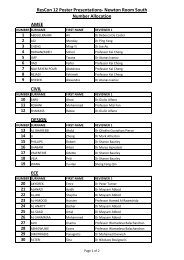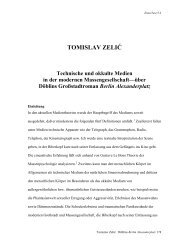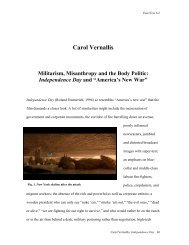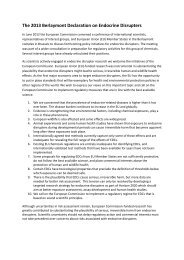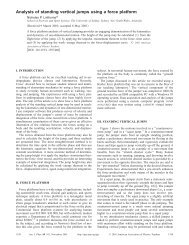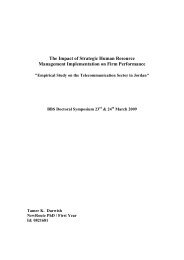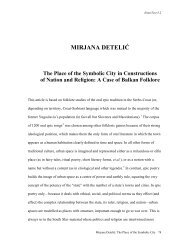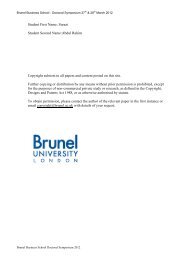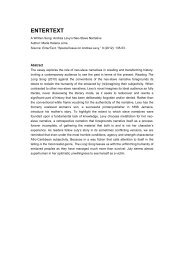Brunel's Olympic Hopefuls - Brunel University
Brunel's Olympic Hopefuls - Brunel University
Brunel's Olympic Hopefuls - Brunel University
You also want an ePaper? Increase the reach of your titles
YUMPU automatically turns print PDFs into web optimized ePapers that Google loves.
“ Having only one<br />
superpower is unusual.<br />
Two has been common,<br />
and three of four not<br />
unusual since political<br />
power became global in<br />
the eighteenth century.”<br />
Ray Barrell<br />
Power comes from population,<br />
productivity, participation and<br />
political will. The US is the only<br />
(current) world superpower, in part<br />
because it had the productivity and<br />
the political will to face its main<br />
competitor, the USSR, and strain it<br />
until it broke. However, having only<br />
one superpower is unusual. Two has<br />
been common, and three of four<br />
not unusual since political power<br />
became global in the eighteenth<br />
century when the UK and France<br />
competed for dominance. Neither<br />
can now compete with the US, with<br />
its population six times the size of<br />
either, with twenty percent higher<br />
productivity than the UK along<br />
with higher participation in the<br />
workforce and in the armed forces.<br />
It seems obvious to many that<br />
China will be the next great<br />
superpower, matching the US in<br />
terms of output by 2019, which<br />
combined with political will may<br />
be enough. However economic<br />
and political power comes from<br />
alliances and networks as well as<br />
capabilities, and the US stands at<br />
the centre of a network in the<br />
Americas and Europe, whilst China<br />
is attempting to build one in Africa<br />
and South Asia. It may also be<br />
difficult for China to forge ahead as<br />
its growth has been very dependent<br />
on high levels of investment, and<br />
the US remains the technological<br />
frontier. Being ahead in terms of<br />
innovation depends on institutions,<br />
and those associated with US and<br />
UK style market systems have<br />
for the last 200 years kept these<br />
countries ahead of others, with<br />
the US economy strengthening in<br />
the last two decades relative to<br />
continental Europe. By the time<br />
China is genuinely able to take the<br />
lead as the largest world economic<br />
OPINION :: LINK MAGAZINE<br />
21<br />
power, India may catch it up. Its<br />
growth has been based much more<br />
on human capital and is probably<br />
sustainable for longer as a result.<br />
It would be possible for Europe to<br />
have as much presence as the US,<br />
and in many ways it does in the<br />
global economy. This was indeed<br />
the objective of the founding<br />
fathers of the European Union, but<br />
they also wanted political presence.<br />
The population of the European<br />
Union is larger than that of the<br />
US, but they are not politically<br />
united. If debate is to be about<br />
the next economic superpower,<br />
it remains possible that Europe<br />
could match the US at the same<br />
time China does, creating a three<br />
power world. This would require<br />
significantly increased economic<br />
integration and decision making<br />
at the centre, and this may be the<br />
outcome of the crisis in the Euro.<br />
Integration has to properly take<br />
a move forward, and if it does<br />
not, we may see disintegration.<br />
European integration is a political<br />
process, and the will appears to<br />
be present to ensure that the<br />
continent remains strong. Its debts<br />
are lower than those of the US, and<br />
it has many spare resources, which<br />
reforms could shake free to use.<br />
Over the next decade we may see<br />
the emergence of a tri-polar world<br />
economy, based on the US, Europe<br />
and China, each equally large by<br />
2020. The two new superpowers, in<br />
economic terms, China and Europe<br />
may look different, with Europe<br />
more often siding with the US. In<br />
the next 20 years China may draw<br />
ahead, but India will by then be<br />
catching up. A four pole world<br />
would be possible by 2035. It will<br />
be fascinating to watch.




